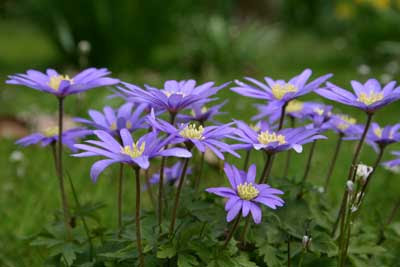"Anemone" translated from Greek, means "wind", for it was believed that spring winds caused them to bloom. Just as the winds caused them to bloom, so the zephyrs blew fragile petals away.
Anemones are native to the Mediterranean region where winters are warm and summers are dry. There they have a rich heritage in legend and history. Two species are widely available: A. blanda, and A. coronaria.
 Aphrodite's Tears
Aphrodite's Tears
Grecian Wind Flower
Anemone blanda is known as Grecian Wind Flower. According to legend, the flowers sprang from the tears of Aphrodite as she mourned the death of Adonis. The name evokes romantic scenes of ancient temples, and rocky hills swept by Mediterranean breezes. Certainly, the scene gives a clue to its preferred habitat.The name, blanda, does not mean "boring", as our contemporary parlance suggests. Blanda means "pleasant" or "mild." It is pleasant, indeed!
A. blanda is reliably hardy in USDA climate zones 6 through 8. Full sun to partial shade is best; morning sun to light shade throughout the day in southern regions. Well-drained soil is essential. The plant naturalizes readily to spread a spring-time carpet of light blue, pink or white daisy-like flowers on 6" to 8" stems. The fern-like foliage is also quite attractive. In addition to naturalizing, Anemone blanda is desirable for bulb and rock gardens, perennial borders, container and patio gardens.
Spanish Marigold
Poppy Anemone
Anemone coronaria is known as Poppy Anemone, Spanish Marigold, and Florist's Anemone. The flower shape and size is very much like that of a poppy. The name, coronaria, refers to the wreath-like appearance of the stamens. There are two groups of Poppy Anemone widely available: De Caen and St. Brigid.
There are two groups of Poppy Anemone widely available: De Caen and St. Brigid.De Caen anemones produce flowers in bright shades of red, white, blue and pink. They are so-named because they were typically cultivated in the De Caen region of France.
St. Brigid anemones produce double-petal flowers in the same shades. That name was given because they were cultivated in Ireland, and St. Brigid is one of Ireland's patron saints.
A. coronaria is not as cold-tolerant as A. blanda, being reliably hardy in USDA climate zones 8 through 10. However, it tolerates heat much better. Sun exposure and soil moisture requirements for A. coronaria are the same as for A. blanda. These are excellent for bulb gardens, perennial borders, container and patio gardens. They're excellent for cut flower arrangements, too.
Planting and Growing Tips
Though anemones prefer warm climates, they can be enjoyed by gardeners in cooler regions. Planting season for southern gardeners is in the fall. Planting season for northern gardeners is in the spring. Logically, they are commercially available both times of year. The best selection is usually in the fall.
 When you receive them, the tubers will be shriveled and dry. That's normal. Simply soak them over-night in water at room temperature before planting. Don't skip this step!
When you receive them, the tubers will be shriveled and dry. That's normal. Simply soak them over-night in water at room temperature before planting. Don't skip this step!The planting site should be well-drained and in full sun to partial shade.
Plant the tubers 6" to 10" apart in the garden and 1" to 3" deep, depending upon the size. Sometimes it's difficult to tell which side is up. Don't worry about it, they will re-orient themselves.
Water thoroughly but gently, taking care not to wash the bulbs to the surface. If planted in the fall, the roots will develop throughout the cool months and flowers will appear in spring. If planted in the spring, the flowers will appear.
Water as needed to maintain slightly moist soil during spring and fall. Anemones are drought-tolerant during summer.
Flowering lasts about four weeks. When blooming is completed, let the foliage remain to build food reserves for next year. Foliage may be removed when it yellows and dies back. Take care to leave the bulbs undisturbed. After a few months of dormancy, they will begin another growth cycle.
If you are one of those who tries to stretch the limits of where a plant might be grown successfully, know that Anemone coronaria (De Caen and St. Brigid) benefit from a covering of mulch in USDA climate zones 7 & 8. Anemone blanda benefit from a covering of mulch in USDA climate zones 3 & 4. If you don't want to risk losing them during your cold winters, lift them after the foliage has fallen, then dry and store them over winter.
Container Gardening Tips
As mentioned before, anemones do well in pots and patio gardens. Choose containers with adequate drainage. To improve drainage, place 1" or 2" of polystyrene packing "peanuts" in the bottom of the container. Fill the container with good quality potting soil. Position containers where they will receive full sun to partial shade.Plant the tubers 2" to 3" apart in the pots. This is much closer than if planting in the garden. Again, it is not necessary to consider which side is supposed to be up. After planting, water well, thoroughly and gently soaking the soil.
When blooming is completed, let the foliage remain to build food reserves. Leaves may be removed when they turn brown and dry. Take care to leave the tubers undisturbed in the pots. After a few months of dormancy, they will begin another growth cycle.
If the containers are kept in an area where cold weather is excessive (USDA climate zones 7 & 8 for A. coronaria, or zones 3 & 4 for A. blanda), they should be moved to where they can be protected.
If you've never grown anemones before, you should do so. Their beauty and historic legacy will lend color and interest to your gardening experience.
Return to GoGardenNow.com.






No comments:
Post a Comment